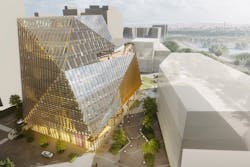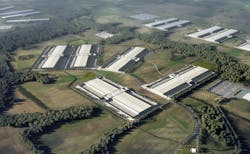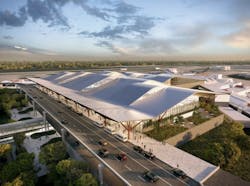While the overall construction market is expected to spend much of 2021 recovering from the double-digit downturn it experienced in 2020 because of the COVID-19 pandemic, Electrical Wholesaling’s editors still found a surprising amount of interesting construction projects on the drawing boards, underway or nearing their start dates. We thought it might be interesting to highlight several large projects in what we believe will be the most active construction niches. In addition, you can find information on more than 30 other large projects by clicking here.
The following project profiles were selected to represent niches in the construction market that will offer electrical construction professionals solid business opportunities in 2021. When you consider that the electrical portion of a typical construction project is roughly 10% of the total cost, the potential revenue impact any of these projects would have on electrical distributors, reps, manufacturers, electrical contractors, design and engineering firms and others in their local markets’ electrical construction communities is substantial. Here are the projects featured in this article:
- Big-time solar projects – Samson Solar Energy Center in northeastern Texas
- Mixed-use urban redevelopment projects – National Landing and Potomac Yard in northern Virginia
- Offshore wind farms - Sunrise, South Fork and Revolution Wind Projects off the coast of New York, Connecticut and Rhode Island
- Data centers – Golden Plains Technology Park, Kansas City, MO
- Airports – Pittsburgh International Airport, Pittsburgh, PA
- Freight infrastructure - Cold-Storage Facility at Ted Stevens Anchorage International Airport Anchorage, AK
If you need this type of project data on a more regular basis, Electrical Marketing (www.electricalmarketing.com) offers quarterly project updates as part of a $99 annual subscription.
Samson Solar Energy Center
Franklin, Lamar and Red River Counties in northeast Texas
The $1.6 billion Samson Solar Energy Center that began construction about six months ago is a good example of one of the larger solar projects underway. It’s huge -- according to information at www.samsonsolarenergycenter.com, when complete the project will generate 1,310 MW -- enough electricity to power 300,000 American homes and provide electricity for nearby operations of AT&T (500 MW); Honda (200 MW); McDonald’s (160 MW); Google (100 MW); and Home Depot (50 MW). It will also provide power for three municipalities in northeast Texas – Bryan (150 MW); Denton (75 MW); and Garland (25 MW).
The job is expected to take 36 months to complete and provide more than 600 construction jobs. It will be constructed in five phases over the next three years and is expected to be operational in 2023. When complete, it will produce enough energy to power nearly 300,000 American homes.
Large solar and wind projects are nothing new for Invenergy, the Chicago-based developer, as it has developed more than 25,000 MW of projects around the world now in operation, construction or contracted. These projects include not only large wind and solar farms, but natural gas-power generation facilities and energy storage, according to the website.
The future looks bright for large commercial and utility-scale solar and wind projects, and well as for other types of renewables. Green enthusiasts believe the new Biden Administration will offer increased support for renewables. According to the executive summary of the 4Q 202 Solar Market Insight Report published by the Solar Energy Industries Association (www.seia.org) and Wood/Mackenzie, “Demand for utility solar has increased, with many regions announcing higher renewable targets not only through state RPS (Renewable Portfolio Standard) policies but also from local utilities announcing solar procurement plans or carbon reduction targets. While utilities in states such as California, Colorado and Washington have announced carbon reduction targets as a means of aligning with state policies, several utilities are also pushing for targets above and beyond state policies. Combined with competitive economics, these new announcements will lead to growth in states like Arkansas, Indiana, Missouri and other states without favorable state-wide renewable energy policy.”
Virginia Tech Innovation Center at Potomac Yard
Alexandria, VA
You can understand why Amazon’s $2.5 billon HQ2 headquarters that’s part of National Landing mixed-used project underway across the Potomac River from Washington, DC, grabs so many headlines, with its plans for 6 million sq ft of office space, 25,000 jobs by the mid-2030s, and the billions in mass-transit support work it’s expected to create over the next decade. But the $1 billion Virginia Tech Innovation Center at Potomac Yard expected to begin construction this summer in nearby Alexandria, VA, stands tall on its own merits because of its innovative design to enhance production of solar power. A project update at www.vt.edu said construction of the 11-story, 300,000 sq-ft building calls for project completion in 2024.
Virginia Tech said SmithGroup, the developer, “utilized computational and generative design techniques to inform the building’s unique geometry. The form was sculpted to capture the sun’s light and energy to maximize photovoltaic power generation. The building will include a space frame to allow for a rooftop solar array, while plans incorporate photovoltaics directly into the glazing system throughout the facade.”
In addition to two more 150,000-sq-ft educational facilities, construction plans for the Innovation Campus call for six other six buildings, including office, residential and ground-level retail space.
Golden Plains Technology Park
Kansas City, MO
Data centers have been one of the hottest construction niches over the past decade. 2020 was very busy, particularly for the firms that lease out data center capacity to tenants. According to a post at www.datacenterknowledge.com, customers of multi-tenant data center facilities leased close to 700 MW – triple the amount leased in 2019.
Even considering this growth, you don’t often run across plans for a data center complex the size of the Golden Plains Technology Park proposed by Diode Ventures. According to a post at www.datacenterdynamics.com, Diode Ventures, a subsidiary of Kansas City metro-based Black & Veatch, one of the nation’s largest engineering firms, envisions a data center campus with up to 13 data centers that would be built in three phases near Kansas City International Airport. The timing of construction would depend on market demand by companies that want to house their data at the facility. Each phase would cost about $1.5 billion to $2 billion. That post said, “If Golden Plains Technology Park is fully built out by 2036, the campus could become one of the world’s largest -- with each phase planned to have a critical IT load of up to 200MW.”
Sunrise, South Fork & Revolution Offshore Wind Farms
Off the coast of Connecticut, Rhode Island and New York
There’s been lots of talk over the last few years about the offshore wind resources along the Atlantic Coast, but outside of the 30 MW Block Island wind farm off the coast of Rhode Island, none of the talk had turned into reality. That will be changing soon, once construction commences for three wind farms off the coasts of Connecticut, New York and Rhode Island. The first of these offshore wind farms expected to connect will be South Fork project being developed by Ørsted and Eversource off the coast of New York. It will feature 15 offshore wind turbines and generate enough clean energy to power 70,000 homes under a long-term power purchase agreement with Long Island Power Authority. The developers are constructing the South Fork Wind Farm about 35 miles east of Montauk Point to meet the growing demand for more power in Long Island, NY.
To connect the wind turbines to the substation, the construction team will install a 138kV underground transmission cable from the offshore wind turbines to the East Hampton Substation in New York. The route selected will allow the team to cross under a major roadway, stay in existing rights of way, and avoid wetlands. On this route, the crews will install an underground duct bank complete with concrete-encased conduit and cable vaults.
The next project to be commissioned will be the Revolution Wind project with an estimated 80 wind turbines off the Rhode Island and Connecticut coasts. The project will power more than 400,000 homes in those states. As part of the project, project developers Ørsted and Eversource are working with the state of Connecticut and the Connecticut Port Authority to invest $77.5 million to redevelop New London State Pier to support construction. About 460 construction jobs will be created by transforming the pier into a heavy-lift cargo and deep-water port. In addition, Ørsted and Eversource are investing $40 million into port infrastructure improvements in Rhode Island.
This type of onshore construction will probably provide the most electrical construction opportunities, as the offshore work of installing the massive turbines is highly specialized and typically handled by Europeans firms with years of experience with the many wind farms in Europe. According to data at www.windeurope.org, in 2019 there were more than 5,000 offshore wind turbines operating in 110 wind farms off the coasts of 12 countries.
The third and largest project planned to date, Sunrise, will use 110 wind farms to power more than a half million homes in New York. To help meet the goals of New York’s Climate Leadership and Community Protection Act, including 9,000MW by 2035, New York State Energy Research and Development Authority (NYSERDA) last year executed contracts with Equinor Wind US LLC for its 816 MW Empire Wind Project and Sunrise Wind LLC (a joint venture of Ørsted A/S and Eversource Energy) for its 880 MW Sunrise Wind Project to deliver clean, affordable, and renewable energy to New Yorkers.
South Fork Wind Farm is expected to begin construction in 2021 and be completed by 2022; Sunrise is scheduled to go into operation by Dec. 2024. Work is slated to start on Revolution in 2021 and wrap up in 2023. South Fork, however, will likely be delayed due to federal permitting delay approvals and COVID-19, which has impacted the ability to carry out key surveys both on and offshore. A formal update from the federal government on the permitting timeline will inform the project schedule. Similarly, Sunrise and Revolution may also have schedule impacts due to the pandemic.
Note: This project summary was excerpted from an article written by freelance writer Amy Fischbach and originally published in the Aug. 2020 issue of EC&M magazine. You can check out other green projects highlighted in that issue at www.ecmwweb.com.
Pittsburgh International Airport
Pittsburgh, PA
It doesn’t seem all that long ago that Pittsburgh opened a new airport. It was quite unique when it opened in 1992 because of the amount of retail shops it had beyond the security gates, and a light-rail system to shuttle passengers to and from departures and arrivals. The city is investing in another upgrade, and although construction is delayed on the $1.1 billion, 700,000-sq-ft new terminal for departures and check-in, security and baggage claim because of the COVID-19 pandemic, design work continues. Gensler, Luis Vidal + Architects and the Allegheny County Airport Authority are working with the HDR engineering firm on a green design that blends the latest in energy-efficient construction materials with “a right-sizing” philosophy that will cut down on the number of gates the older airport had, but allows passengers to get to gates in half the time. The new terminal will have triple the amount of covered parking.
Cold-Storage Facility at Ted Stevens Anchorage International Airport
Anchorage, AK
The U.S. freight logistics and supply chain quietly provides a surprising amount of construction opportunities. Over the past few years, that has included new intermodal rail freight facilities where shipping containers are transferred between freight trains; expanded ocean port facilities to handle the latest generation of container ships that can handle more than 20,000 TEUs (shipping containers); and upgraded rail freight lines that can handle freight cars with double-decker shipping containers have provided plenty of construction opportunities.
EW’s editors recently learned about a freight project of a different sort in Alaska that when complete will provide new cold storage capacity for refrigerated food and other products on one of the world’s major air freight shipping routes – the Great Circle Route. Alaska Cargo and Cold Storage (ACCS) signed a 55-year ground lease with the state of Alaska for a 700,000-sq-ft cold storage facility strategically located at Ted Stevens Anchorage International Airport, the sixth-busiest cargo airport in the world.
“This project will improve shipping to and through Anchorage, create jobs, and show the world that Alaska is open for business,” said Alaska Governor Mike Dunleavy in the press release announcing the new facility. “We’re excited about the potential this integral piece of the global cold chain has to make Ted Stevens Anchorage International Airport and Alaska a more attractive place for global companies to do business.”
According to the press release, being located on the Great Circle Route, means the Anchorage airport location is within 9.5 hours of 90% of key markets in Asia, Europe and North America. “We believe Alaska offers world-class development and investment opportunities,” said Rob Gillam, chief investment officer at McKinley Capital, one of the backers for the project, in the press release. “ACCS is a clear instance. There are many industries that require cold storage. One example is Alaska seafood, one of Alaska’s biggest exports, and it’s shipped globally. For decades, almost no value-added or fresh production occurred in-state. ACCS will lead the way in changing that trend. Now, Alaska can capitalize on its valuable position as a hub between North America and Asia. We see this project as something with potential to increase air cargo traffic and spur local economic development.”
In September 2020, the U.S. Department of Transportation awarded the Alaska Energy Authority (AEA), a $21 million BUILD grant to administer in support of the ACCS project.
The facility will be constructed in phases. The first phase will be roughly 190,000 sq ft with plans to begin construction in the second half of 2021. When fully completed, the facility will offer cold and warm storage, quick cargo, and general warehousing options, logistics services, and auxiliary space for tenant offices.
About the Author
Jim Lucy
Editor-in-Chief of Electrical Wholesaling and Electrical Marketing
Jim Lucy has been wandering through the electrical market for more than 40 years, most of the time as an editor for Electrical Wholesaling and Electrical Marketing newsletter, and as a contributing writer for EC&M magazine During that time he and the editorial team for the publications have won numerous national awards for their coverage of the electrical business. He showed an early interest in electricity, when as a youth he had an idea for a hot dog cooker. Unfortunately, the first crude prototype malfunctioned and the arc nearly blew him out of his parents' basement.
Before becoming an editor for Electrical Wholesaling and Electrical Marketing, he earned a BA degree in journalism and a MA in communications from Glassboro State College, Glassboro, NJ., which is formerly best known as the site of the 1967 summit meeting between President Lyndon Johnson and Russian Premier Aleksei Nikolayevich Kosygin, and now best known as the New Jersey state college that changed its name in 1992 to Rowan University because of a generous $100 million donation by N.J. zillionaire industrialist Henry Rowan. Jim is a Brooklyn-born Jersey Guy happily transplanted with his wife and three sons in the fertile plains of Kansas for the past 30 years.






